PONTIAC GRAND PRIX 1998 Repair Manual
Manufacturer: PONTIAC, Model Year: 1998, Model line: GRAND PRIX, Model: PONTIAC GRAND PRIX 1998Pages: 402, PDF Size: 17.96 MB
Page 61 of 402
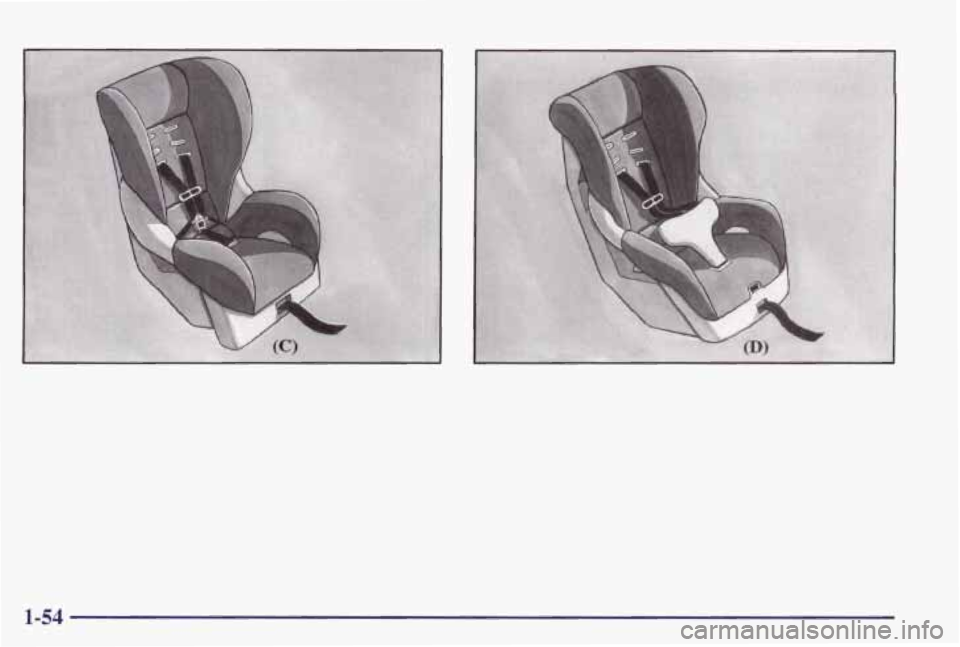
1-54
Page 62 of 402
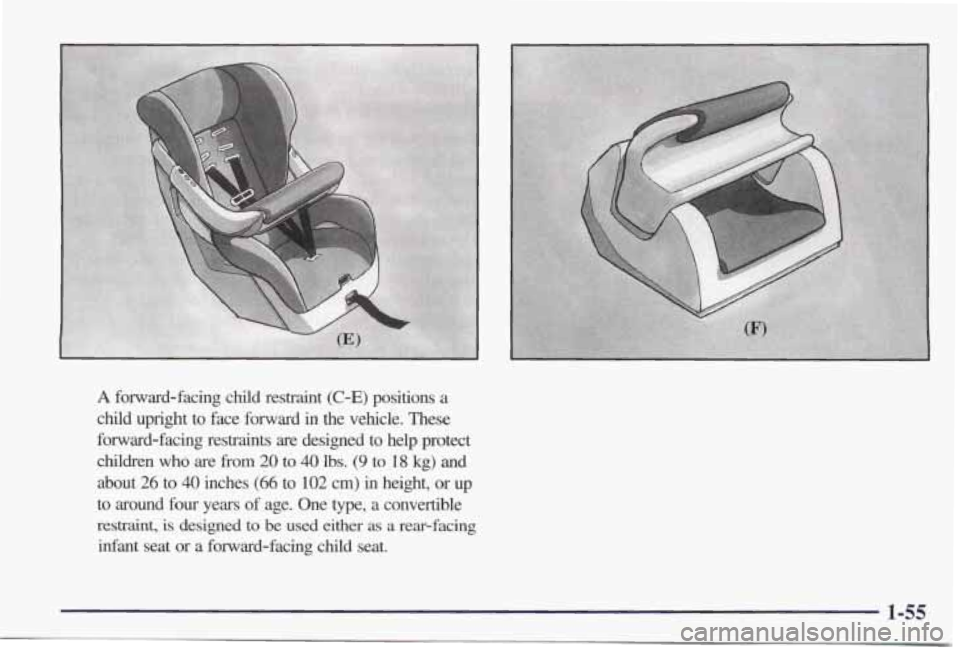
A forward-facing child restraint (C-E) positions a
child upright to face forward in the vehicle. These
forward-facing restraints are designed to help
protect
children who are from 20 to 40 lbs. (9 to 18 kg) and
about 26
to 40 inches (66 to 102 cm) in height, or up
to around
four years of age. One type, a convertible
restraint, is designed to be used either as a rear-facing
infant seat
or a forward-facing child seat.
Page 63 of 402
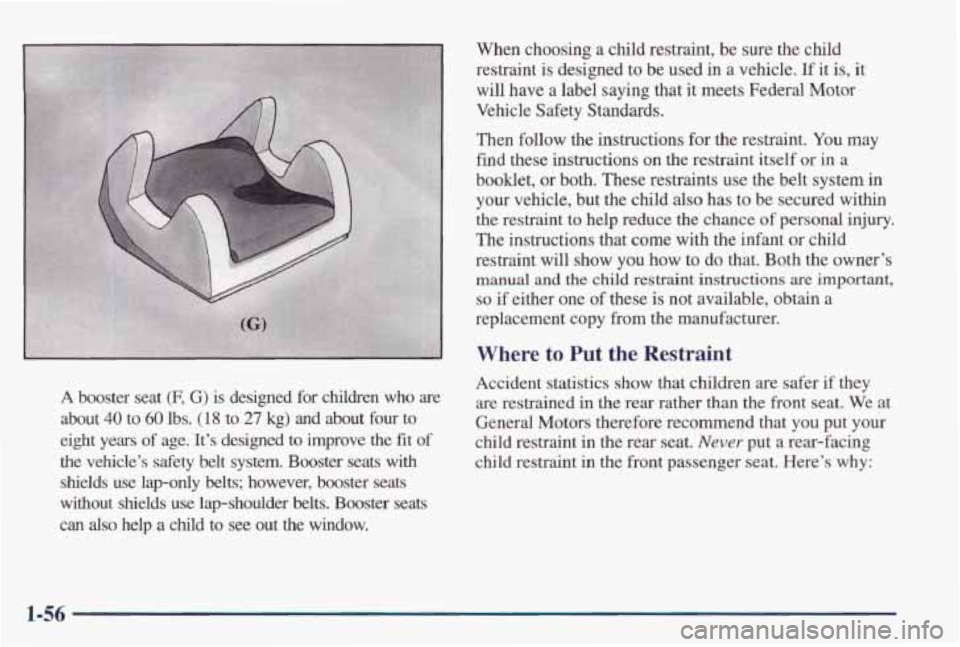
A booster seat (F, G) is designed for children who are
about 40 to 60 lbs. (1 8 to 27 kg) and about four to
eight years
of age. It’s designed to improve the fit of
the vehicle’s safety belt system. Booster seats with
shields use lap-only belts; however, booster seats
without shields use lap-shoulder belts. Booster seats
can also help a child to see out the window. When choosing
a child restraint, be sure the child
restraint
is designed to be used in a vehicle. If it is, it
will have
a label saying that it meets Federal Motor
Vehicle Safety Standards.
Then follow the instructions
for the restraint. You may
find these instructions on the restraint itself
or in a
booklet,
or both. These restraints use the belt system in
your vehicle, but the child
also has to be secured within
the restraint to help reduce the chance
of personal injury.
The instructions that come with the infant or child
restraint will
show you how to do that. Both the owner’s
manual
and the child restraint instructions are important,
so if either one of these is not available, obtain a
replacement copy from
the manufacturer.
Where to Put the Restraint
Accident statistics show that children are safer if they
are restrained in the rear rather than the front seat. We at
General Motors therefore recommend that you put your
child restraint in the rear seat.
Never put a rear-facing
child restraint in the front passenger seat. Here’s
why:
1-56
Page 64 of 402
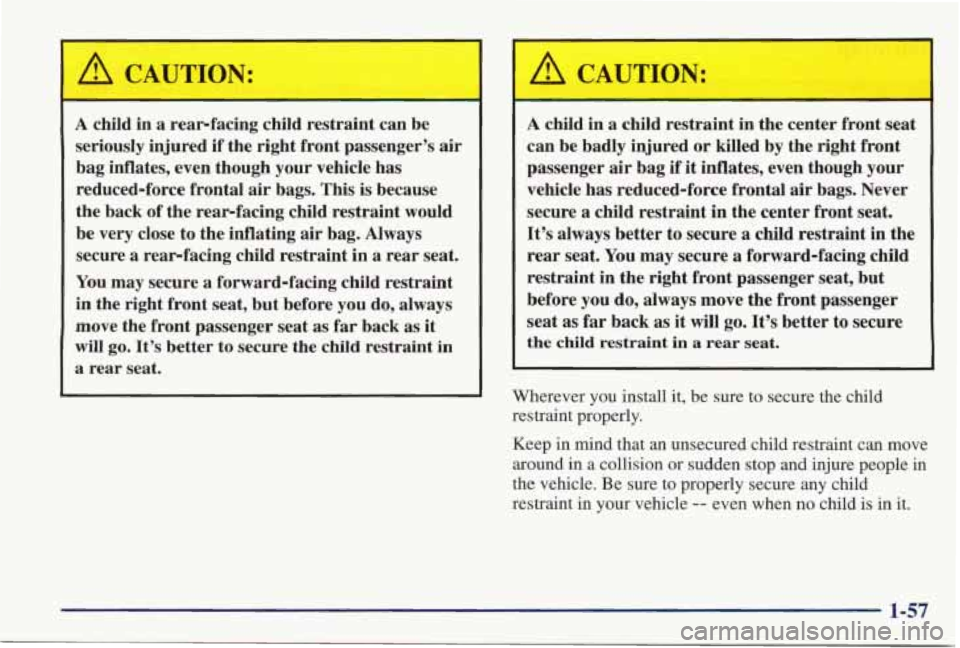
I A CAUTION:
A child in a rearfacing child restraint can be
seriously injured if the right front passenger’s air
bag inflates, even though your vehicle has
reduced-force frontal air bags. This is because
the back of the rear-facing child restraint would
be very close to the inflating air bag. Always
secure a rearfacing child restraint
in a rear seat.
You may secure a forward-facing child restraint
in the right front seat, but before you do, always
move the front passenger seat as far back
as it
will go. It’s better to secure the child restraint in
a rear seat.
A CAUTION:
A child in a child restraint in the center front seat
can be badly injured or killed by the right front
passenger air bag if it inflates, even though your
vehicle has reduced-force frontal air bags. Never
secure a child restraint in the center front seat.
It’s always better to secure a child restraint in the
rear seat. You may secure
a forward-facing child
restraint in the right front passenger seat, but
before you do, always move the front passenger
seat
as far back as it will go. It’s better to secure
the child restraint in a rear seat.
Wherever you install it, be sure to secure the child
restraint properly.
Keep in mind that an unsecured child restraint can move around in
a collision or sudden stop and injure people in
the vehicle. Be sure
to properly secure any child
restraint in your vehicle
-- even when no child is in it.
Page 65 of 402
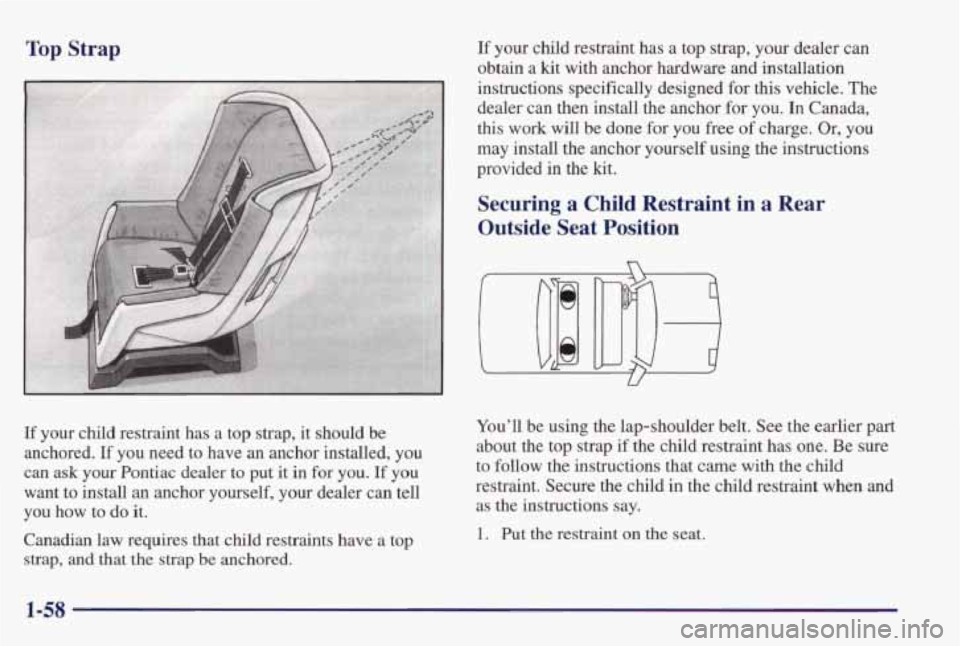
Top Strap If your child restraint has a top strap, your dealer can
obtain a
kit with anchor hardware and installation
instructions specifically designed for
this vehicle. The
dealer can then install the anchor for you.
In Canada,
this work will be done for you free of charge. Or, you
may install the anchor yourself using the instructions
provided in the kit.
Securing a Child Restraint in a Rear
Outside Seat Position
If your child restraint has a top strap, it should be
anchored. If you need to have
an anchor installed, you
can
ask your Pontiac dealer to put it in for you. If you
want to install
an anchor yourself, your dealer can tell
you
how to do it.
Canadian law requires that child restraints have a top
strap, and that the strap be anchored. You'll be using the
lap-shoulder belt. See the earlier part
about the top strap if the child restraint has one. Be
sure
to follow the instructions that came with the child
restraint. Secure the child in the child restraint when and
as the instructions say.
1. Put the restraint on the seat.
1-58
Page 66 of 402
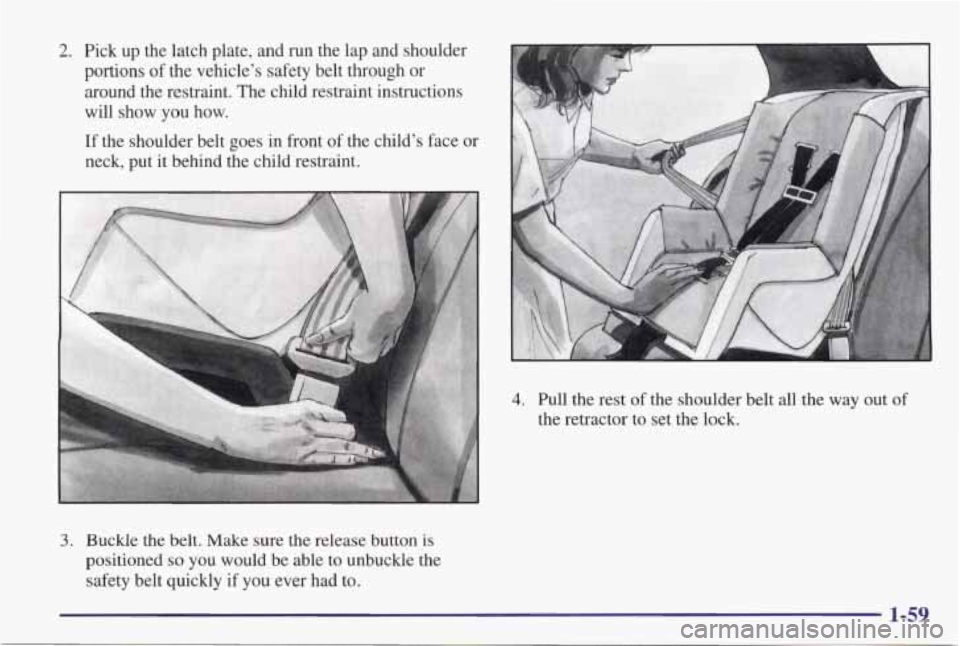
2. Pick up the latch plate, and run the lap and shoulder
portions of the vehicle’s safety belt through or
around the restraint. The child restraint instructions
will show
you how.
If the shoulder belt goes in front of the child’s face or
neck, put it behind the child restraint.
L
4. Pull the rest of the shoulder belt all the way out of
the retractor to set the lock.
3. Buckle the belt. Make sure the release button is
positioned so you would be able to unbuckle the
safety belt quickly if you ever had to.
1-59
Page 67 of 402
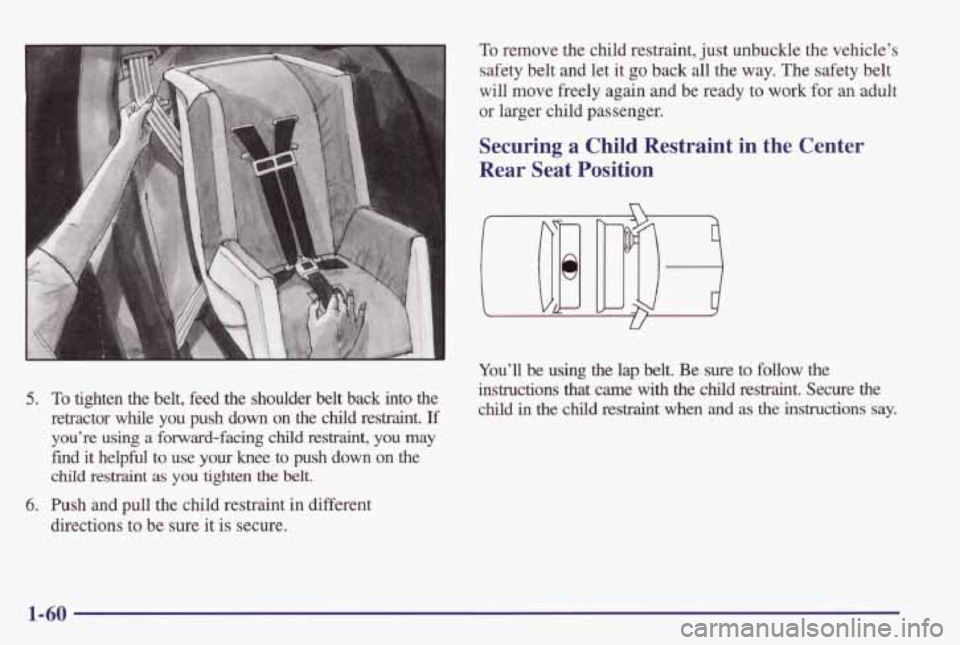
To remove the child restraint, just unbuckle the vehicle’s
safety belt and let it
go back all the way. The safety belt
will move freely again and be ready to work for
an adult
or larger child passenger.
Securing a Child Restraint in the Center
Rear Seat Position
u
You’ll be using the lap belt. Be sure to follow the
5. To tighten the belt, feed the shoulder belt back into the
retractor
while you push down on the child restraint. If
instructions that came-with the child restraint. Secure the
child in the child restraint when and as the instructions say.
you’re using
a forwk-d-facing child restmint, you may
find it helpful to use your knee to push down on the
child restraint as you tighten the belt.
6. Push and pull the child restraint in different
directions to be sure it
is secure.
1-60
Page 68 of 402
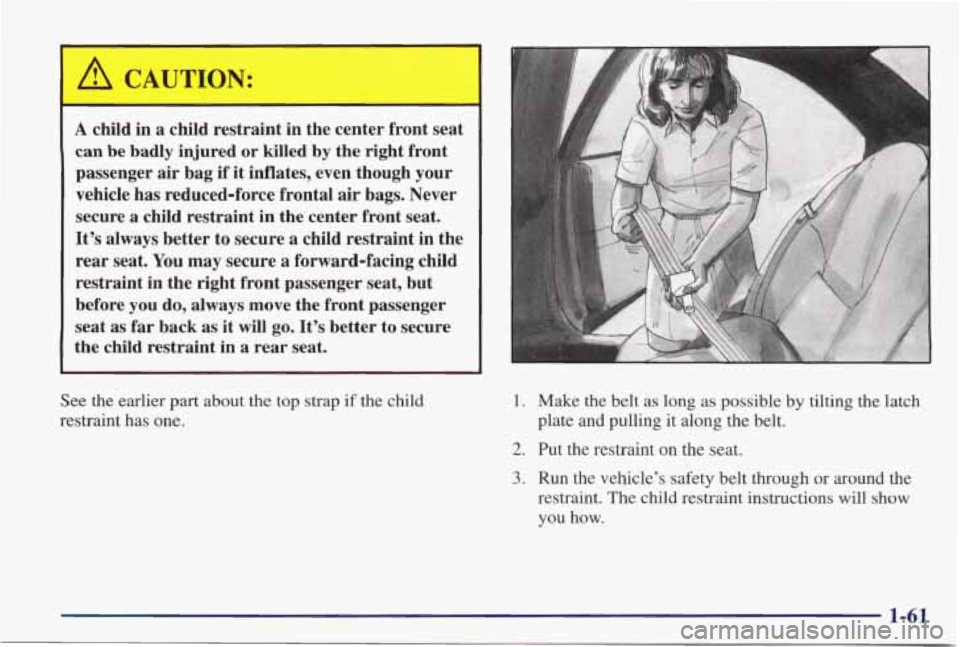
A child in a child restraint in the center front seat
can be badly injured or killed by the right front
passenger air bag if it inflates, even though your
vehicle has reduced-force frontal air bags. Never
secure a child restraint in the center front seat.
It’s always better to secure a child restraint in the
rear seat.
You may secure a forward-facing child
restraint in the right front passenger seat, but
before you do, always move the front passenger
seat as far back as it will go. It’s better to secure
the child restraint in a rear seat.
I I
See the earlier part about the top strap if the child
restraint has one. 1. Make the belt as long as possible by tilting the latch
plate and pulling it along the belt.
2. Put the restraint on the seat.
3. Run the vehicle’s safety belt through or around the
restraint. The child restraint instructions will
show
you how.
1-61
Page 69 of 402
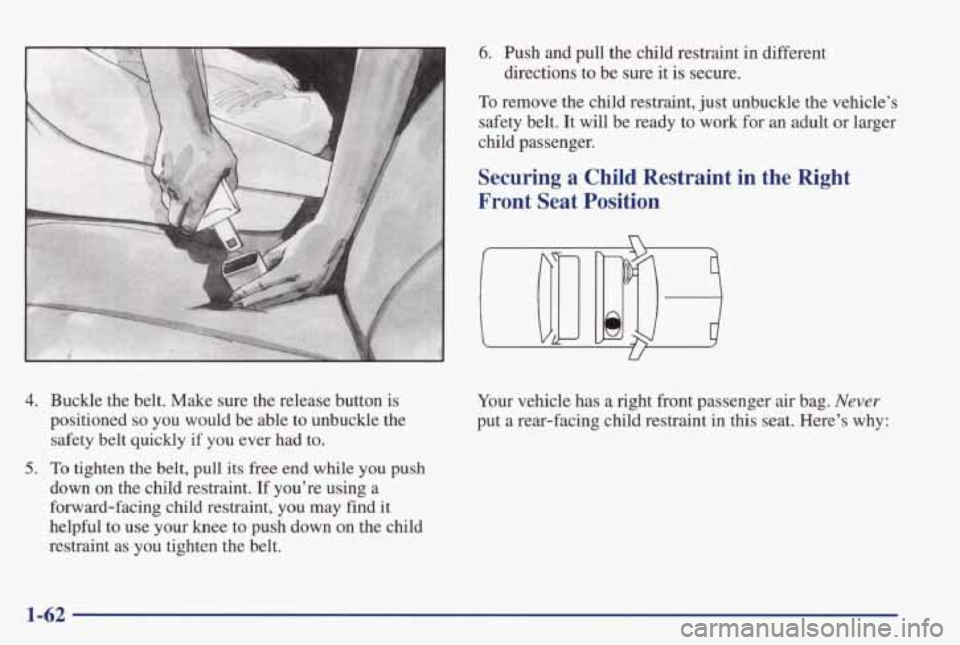
4. Buckle the belt. Make sure the release button is
positioned
so you would be able to unbuckle the
safety belt quickly if you ever had to.
5. To tighten the belt, pull its free end while you push
down on the child restraint.
If you’re using a
forward-facing child restraint, you may find
it
helpful to use your knee to push down on the child
restraint as you tighten the belt.
6. Push and pull the child restraint in different
directions to be sure
it is secure.
To remove the child restraint, just unbuckle the vehicle’s
safety belt. It will be ready to work for
an adult or larger
child passenger.
Securing a Child Restraint in the Right
Front Seat Position
Your vehicle has a right front passenger air bag. Never
put a rear-facing child restraint in this seat. Here’s why: \
1-62
Page 70 of 402
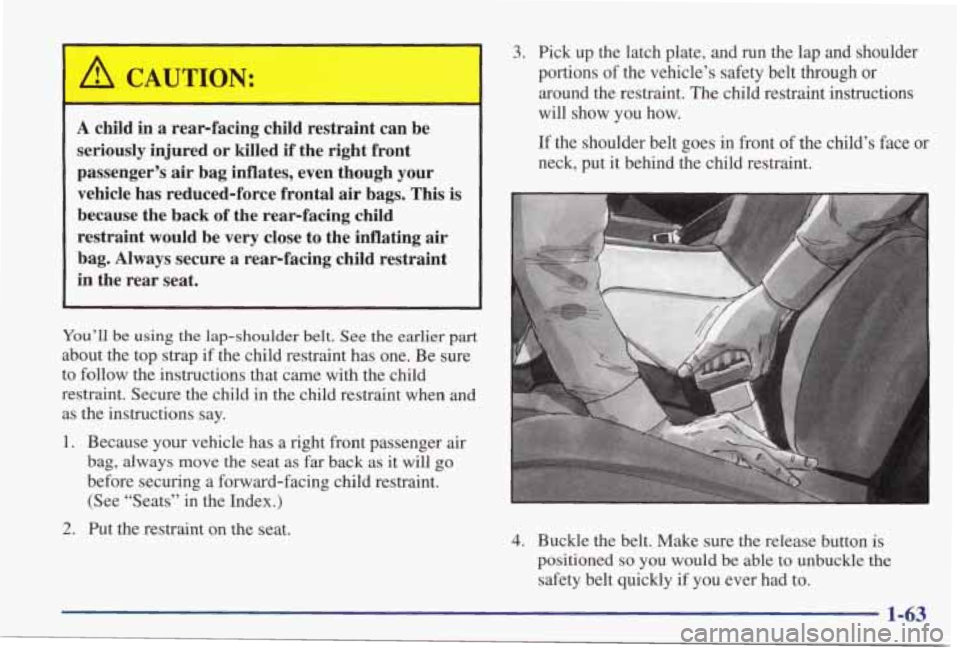
A child in a rearfacing child restraint can be
seriously injured or killed if the right front
passenger’s
air bag inflates, even though your
vehicle has reducedlforce frontal air bags. This is
because the back
of the rearfacing child
restraint would be very close to the inflating air
bag. Always secure a rearfacing child restraint
in the rear seat.
You’ll be using the lap-shoulder belt. See the earlier part
about the top strap if the child restraint has one. Be sure
to follow the instructions that came with the child
restraint. Secure the child in the child restraint when and
as the instructions say.
1. Because your vehicle has a right front passenger air
bag, always move the seat as
far back as it will go
before securing a forward-facing child restraint.
(See “Seats” in the Index.)
2. Put the restraint on the seat.
3. Pick up the latch plate, and run the lap and shoulder
portions of the vehicle’s safety belt through
or
around the restraint. The child restraint instructions
will show you how.
If the shoulder belt goes in front of the child’s face or \
neck, put it behind the child restraint.
4. Buckle the belt. Make sure the release button is
positioned so you would be able to unbuckle the
safety belt quickly if you ever had to.
1-63